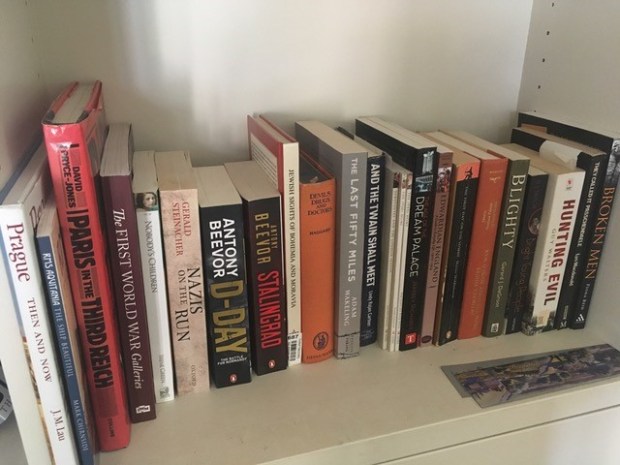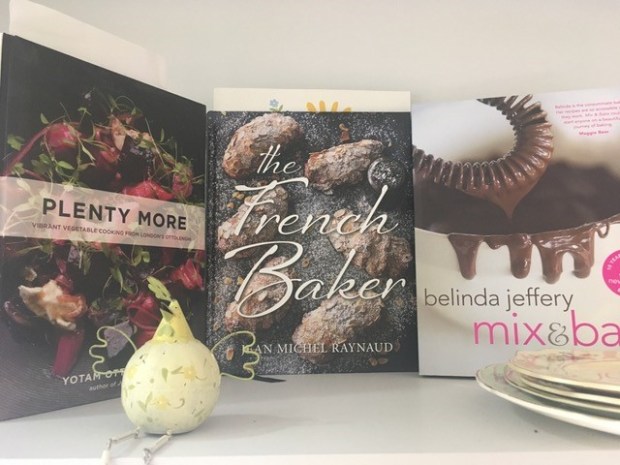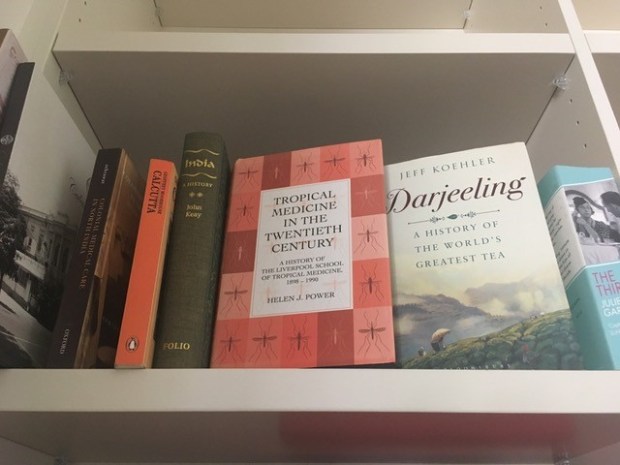
When my book club read Fiona MicIntosh’s historical novel The Lavender Keeper last year, our host Ronnie — who chose the book — created a French Resistance theme for our meeting, and we were all given false papers and new identities, to reflect the book’s theme and World War II setting. I have no doubt that this skilfully crafted, emotionally charged story will prove to be the most popular read by the club in 2017, and I expect several club members will be inspired to seek other titles by Fiona based on their reaction to the story of Luc and Lisette. It was certainly easy to understand why Fiona has become one of Australia’s most popular and highly regarded storytellers, and her latest novel, The Tea Gardens (released by Penguin in October 2017), will likely attract a new wave of fans.
 But there’s more to Fiona than historical fiction. She has also garnered a strong fan base for her adult fantasy series, and her name figures prominently among book industry accolades with each new title. Her non-fiction guide, How to Write Your Blockbuster, has led many, many would-be writers on the path toward finished manuscripts, and her regular masterclasses are entertaining, practical, informative and effective.
But there’s more to Fiona than historical fiction. She has also garnered a strong fan base for her adult fantasy series, and her name figures prominently among book industry accolades with each new title. Her non-fiction guide, How to Write Your Blockbuster, has led many, many would-be writers on the path toward finished manuscripts, and her regular masterclasses are entertaining, practical, informative and effective.
Fiona is married with twins and, according to her website, lives in South Australia, roams the world to research her stories and does her best writing from Tasmania. On her website, Fiona also says she “happily considers eating fine chocolate and drinking only excellent coffee” as her hobbies. She also loves winter boots… and Paris.
I recommend you grab a cup of excellent coffee (or tea), and put your own boots up as you read this fascinating and delightful Shelf Aware guest post from Fiona McIntosh.
Q. How would you describe the work that you do and how you do it?
A. Because it’s how I earn my income I’m near enough corporate about my approach to writing, although this does not mean in my disciplined manner that there’s any compromise to creativity or imagination. In fact, because I do approach my work in such a business-like way there’s a sense of security connected to the uninterrupted, ritualistic hours at the keyboard. That security empowers me to lose myself and let the story romp free, allowing the characters to take charge. I’m part of a professional team that puts out a big earning book each year so we’re working towards one goal, one deadline, one northerly headed sales graph.
The Tea Gardens is my 35th book and I’ve written each one of them to a daily word count. I developed this model more than 17 years ago when I was juggling early motherhood, early marriage and our own business that could easily have demanded 24/7 from the two of us. But there were twin sons to raise, lives to be enjoyed, friends and family to be involved with, and a book I wanted to write. So, I needed to compartmentalise my life. The best way I could do that was to impose strict times on when I wrote and how much I could get done in each session. It was the best motivator I could have dreamt up and now it’s the creed I live by for my storytelling. It always delivers and I never have to become anxious about deadlines. I only write four days per week and for about 16 weeks. I never work on Fridays – they’re for me. And I never write on weekends – they’re for family. In this way I create a happy work/life/writing balance for myself and no one else suffers for my pursuits.
I feel my professional life is an iceberg. The physical writing of the stories is one-tenth. The other nine–tenths are given over to reading up on my subjects, researching for physical locations and hunting down the main story. There’s lots of overseas travel in my life, promotion, marketing, administration, meeting with my publisher, books tours that can straddle three months and soak up a lot of time and headspace and energy. I also host a series of masterclasses – there are several varieties and I host four to five of those big events per year, each with their own demands, admin, dramas, preparation…and help around 50 new writers get onto their pathway towards their polished draft and submission. Plus, I do talks all over the country that requires preparation, I also have to be across social media and doing this sort of thing…writing articles, so my days fill fast.

Q. What can you tell us about your latest book release?
The Tea Gardens exploits the aspect of my writing that works hard to connect the reader to the world of the story… its era, landscape, political times. The story is in a setting of awe and majesty when it takes the reader up into the foothills of the Himalaya. I certainly became speechless at its beauty and hope with all of my heart that I convey that through my character Isla Fenwick. I play with the familiar theme that I do in most of my historical fiction about modern young women of their era, pushing back against society’s norms, and following their path often at the expense of their relationships, be it family or friends.
This story follows Isla, a doctor of the 1930s, who despite accepting that marriage is inevitable is keen to first practice medicine at the coalface around the slums of Calcutta. It’s a story about independence and the realisation that there is an emotional price for being motivated and self-affirmed but also that no matter how strong you may be, we are all vulnerable when it comes to the heart. I do NOT write Romance but I do like to deliver fiction that has romantic themes, settings, destinations, eras to escape with. I like the fashion and lifestyle of my characters especially in the interwar years when this story is set.
I aim to armchair travel my readers and with this story I believe they’ll enjoy the contrast between life in Calcutta, Darjeeling and London…and I’m confident they’ll be fascinated by a couple of the key settings of Brighton Pier in UK and the Brackenridge tea plantation in the foothills of the Himalaya.
It’s always a juggle for a historical fiction writer to balance out the reader’s enrichment of the main topic – in this case, tea, tropical medicine and India –making sure that they feel their knowledge has been enhanced through the reading experience but at no cost to their imaginative pleasure and sigh of satisfaction when they close the book for the final time.
It’s a heart-wrenching tale, I feel, with several characters to admire and one to helplessly enjoy loathing 🙂

Q. Where are the main bookcases in your home or office? Do you also keep books in other places at home (or elsewhere)?
A. I’m at a bit of sixes and sevens with my workplace at the moment because we have recently moved into an old farmhouse and it is still being fixed up. Presently, I’m working in my new country kitchen. I sit at the kitchen bench in a corner nook I designed for the purpose because I knew it would be a year or two before I got the 150 year old barn I dream of writing from renovated to a point that it would become a happy writing space. So I sit to the right of the sink, beneath glass cupboards filled with some of my favourite china and also beneath two large shelves filled with recipe books. I am a cook when I’m not writing and I read cookery books like beloved novels, so this is pleasurable spot for me.

We have bookcases all around our living space in our home back in Adelaide but I am still unpacking boxes that have been archived with books for years and discovering precious reads that I can finally get back up onto a sweep of bookshelves.

In my old office – a tiny room at the top of the stairs that overlooked the rooftops of neighbours – I used to have small towers of books in various categories. It drove my husband mad because I am so messy but those unruly looking towers were ordered chaos in my mind. I can look over at a tower and know the book I want to refer to. I will no doubt achieve my book towers again once I move into the old barn that begins renovations this summer.
For now, we are slowly filling shelves that flank a fireplace in a room designed for quiet time; cosy in winter around the fire or light filled in summer kept cool by thick stone walls and perfect for curling up in an armchair to read. No TV in this room!

Q. How are your books organised/arranged?
A. Presently, as I unpack books I’ve got one side of the room and its sweep of shelves for non-fiction so that’s my research and historical books. The other side will slowly fill with fiction when I find my boxes that are haphazardly stored in a huge shed. Only the books I have loved will get a spot. There is never place on my shelves for ‘filler books’. I give loads away as a result.
Q. What sorts of books predominate?
A. For a fiction writer I realise it’s odd that non-fiction dominates but I acquire oodles of reference material to research my historical novels. My favourite playground is 1910 to the end of WWII so I mostly have titles that refer to the two world wars but they’re broken down into everything from how people lived in, to fashion of, a particular era. I might have highly specific books e.g. about lavender growing or about vintage perfumes, I have books just on Savile Row for instance and plenty of places during the two wars e.g. Paris during the Occupation. I have half a shelf devoted just to India in the previous century, tea plantations and tropical medicine of the first half of the 20th century. But if you looked at the fiction side you’d probably see thrillers, crime fiction, psychological tales, historical and fantasy.
Q. Describe your favourite reading place.
A. I must admit that I do like reading on an aeroplane. This is forced quiet time for me; I am not someone who easily remains still. I like to be achieving something. But, aeroplanes are notorious for conversations with people you’ll unlikely meet again and a book dissuades the awkward social chit chat. I get very little down time and almost no leisure reading time so when I’m forced to be still I love to read and don’t want interruptions. I have a list of books I’ve lined up that I look forward to getting to in these moments. I travel a great deal so I do all my leisure reading in airports and on aeroplanes. So, I tend to be away from home when I do my leisure reading and I am usually at home when I do my research reading and that is always done in bed at the end of the day.
Q. What book/s are you reading right now? Why did you choose that book/those books and what do you think of it/them so far?
I’m on the last third of a novel that I’m writing so all the research reading for that book is done. This means my work reading is for the 2019 novel and right now the books by my bed are teaching me about Amsterdam and Brussels in the early years of the 19th century.
Leisure-wise, I have just finished a book called The Secret Scripture; I read it because a cousin from the UK wrote to me and begged me to read it, citing it as his favourite novel. He isn’t wrong; it’s a powerful tale of betrayal and treachery set in the previous century when women could be sent off to lunatic asylums for little more than a pointed finger from the local priest. A heart-wrenching story. It’s recently become a film but the book is haunting.
I’ve also just downloaded The Handmaid’s Tale which I’ve been meaning to read for years and now I must with all the ballyhoo surrounding the television series that I have deliberately not watched until I read the book. As I am gearing up to go on tour this means lots of waiting around in airports and journeys in planes as we crisscross the country, so I can get some leisure reading done. Can’t wait. I am sweating on the release of the new Terry Hayes book. After I Am Pilgrim, I’m hooked.
I’ve always got a Bill Bryson on the go. He amuses me like few other writers can. I know people always enquire as to what I’m laughing at while I read (on a plane!); it’s one of those things, isn’t it? When someone’s laughing with a book, you can’t help but want to know which book it is.
Q. What are your favourite books and/or who are your favourite authors?
A. My favourite book is Enduring Love by Ian McEwan and I gobble up all of his books because his writing fascinates me and shows me what a long way I have to go.
A recent hit for me was I Am Pilgrim – it was a surprise and I want more from Terry Hayes.
If I’m honest there is a pile of fantasy books that have nourished my reading over the last three decades and given that I began my writing career as a fantasy novelist with books that still sell well all over the world and I haven’t written an epic fantasy for almost a decade, I can’t ignore the pleasure that the books of George R R Martin, Guy Gavriel Kay and Robin Hobb delivered regularly into my life. They are all masters of their craft. The original two books that began with Cross Stitch, or these days known as Outlander, by Diana Gabaldon were unputdownable storytelling.
Some of my classic reads would include The Thorn Birds, Kane and Abel, To Kill A Mockingbird, The Power of One, Rebecca, Jane Eyre. When I want to feel a little frightened I do read Stephen King (he’s so clever) or John Connolly (who masquerades as a crime writer but is a terrific psychological thriller writer).
I love thrillers and there’s a book called The Analyst by John Katzenbach that I recall getting lost with, another called The Eight, and while it’s a bit dated now as a novel, given today’s technology, the original Bourne Identity with Ludlum was a stand-out favourite when I was a late teen and it gave me the impetus to travel the world.
I adore the work of Sharon Penman. Anything she writes brings the deep past back to life for me in vivid detail and in a way that the pages turn themselves. I’d read anything of hers.
Q. In the event of an emergency, if you could save just three books from your collection, which books would they be – and why would you choose them?
A. Tigana by Guy Gavriel Kay
Here Be Dragons by Sharon Penman
Enduring Love by Ian McEwan
Birdsong by Sebastien Faulks.
I know that’s four but I think I’d risk going back into the burning house for the fourth! Each of these titles have had a lasting emotional effect on me and they are books I could read over and again to learn my craft from as much as to get lost and captivated by.
Q. If you could sit down for afternoon tea with your three favourite characters or authors, who would they be, what would you serve them, and what would like to talk to them about?
A. Mr Darcy from Pride and Prejudice
Valentin from Tigana
Tyrion from Game of Thrones
Llewellyn from Here Be Dragons
I’m sorry, I couldn’t leave out the fourth! I’d serve them my latest afternoon tea recipes I’m enjoying…spinach and cheese pasties with spinach from our patch and homemade buttery flaky pastry, black amarena cherry and almond teacake that I bake in a slab, with pots of steaming Darjeeling tea. Must be Darjeeling at the moment because that’s where my research was done for The Tea Gardens and I stayed on a plantation house to learn about tea… it’s a highly romantic destination for anyone who is intrigued by the days of the British Raj. Darjeeling is the emperor of teas to boot for its sparkling, bright taste of exceptional quality long leaves.
I’d likely talk to these delicious gentlemen about their roles in literature; each is a lonely, often misunderstood and yet pivotal character, who is helplessly endearing to the reader despite their flaws. Each suffers pride, a sense of entitlement because of their wealthy status and each over the course of their stories finds heroic power in their ultimate role to – if I can explain it this way – help the underdog within the story to come into their power.
Find out more about Fiona McIntosh on her website or Facebook page.











